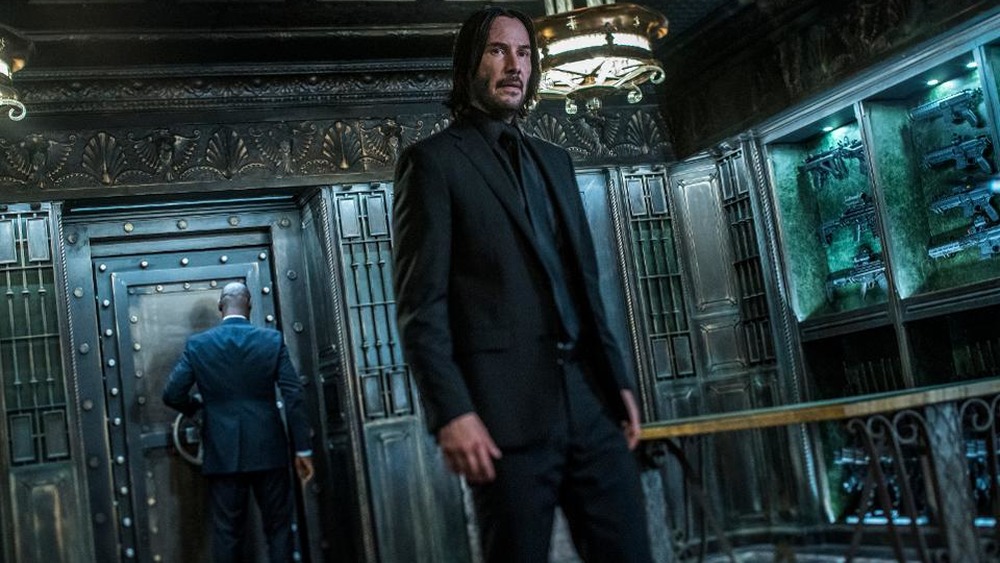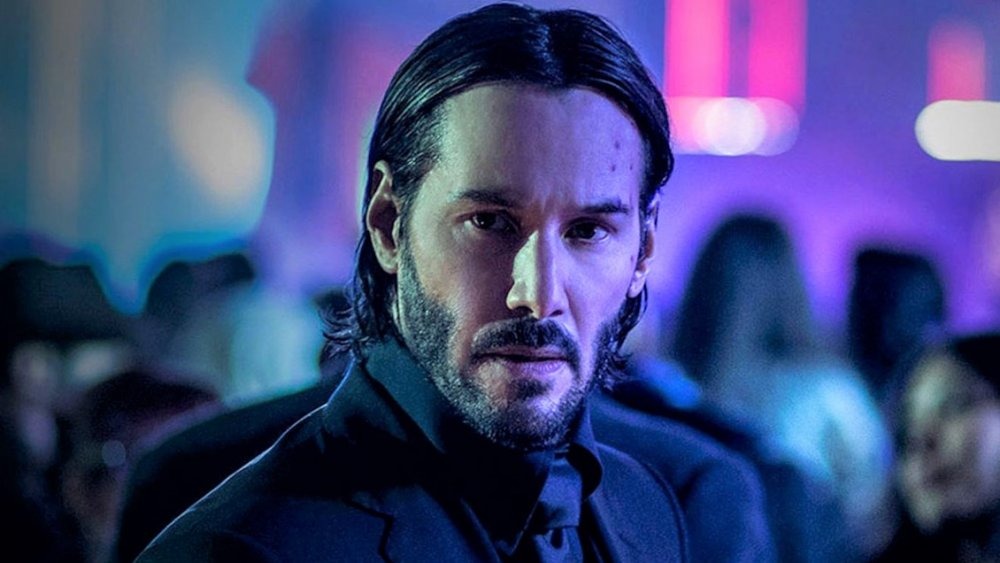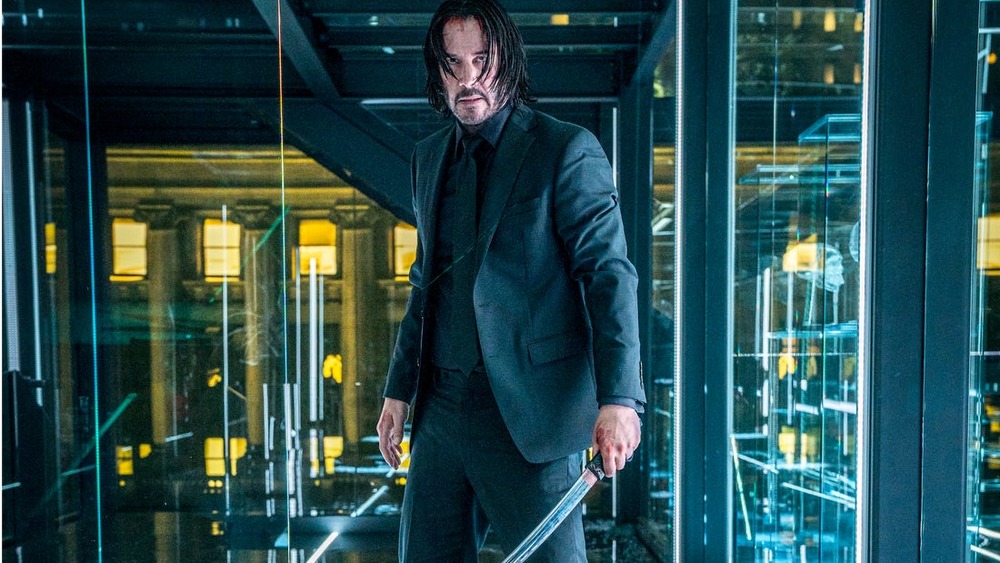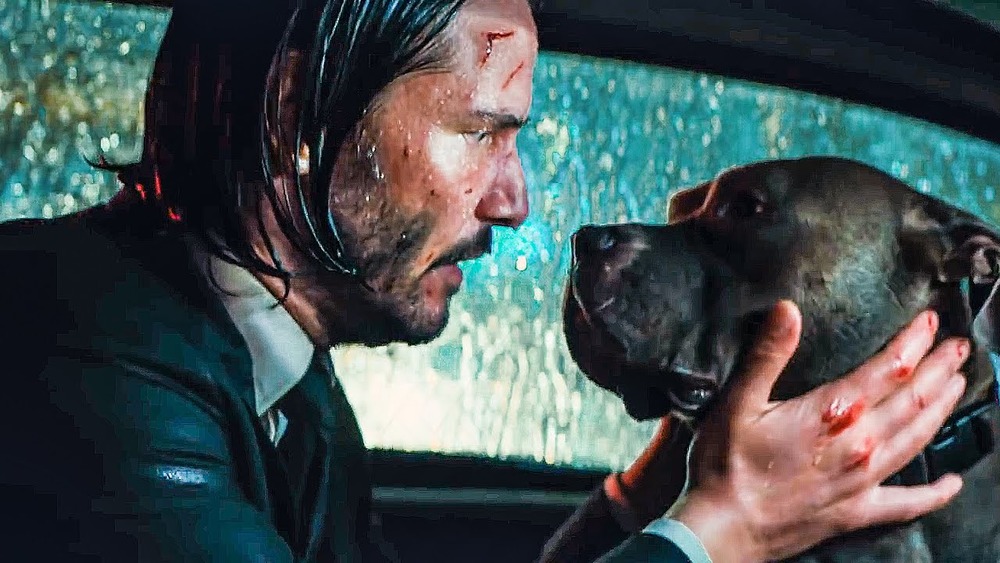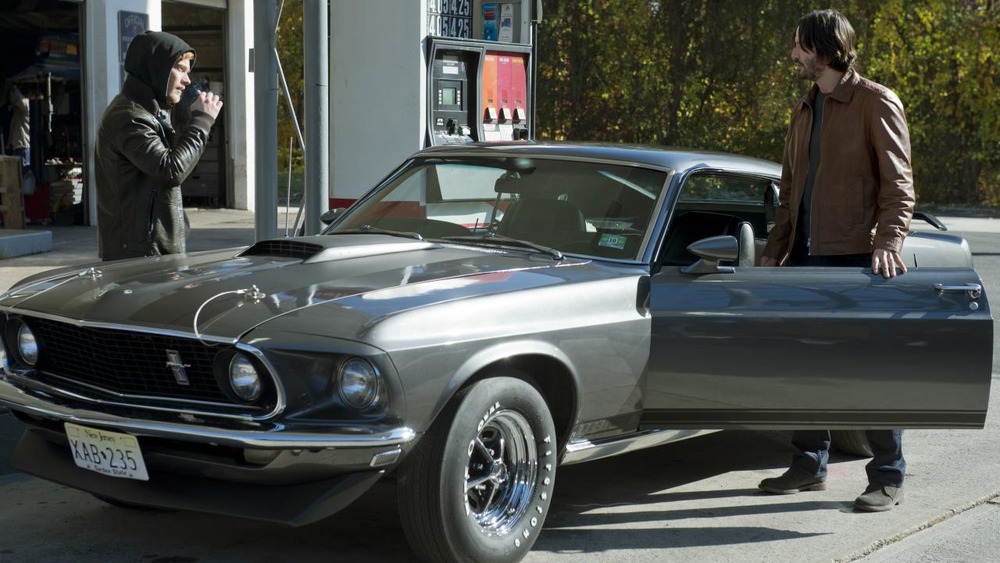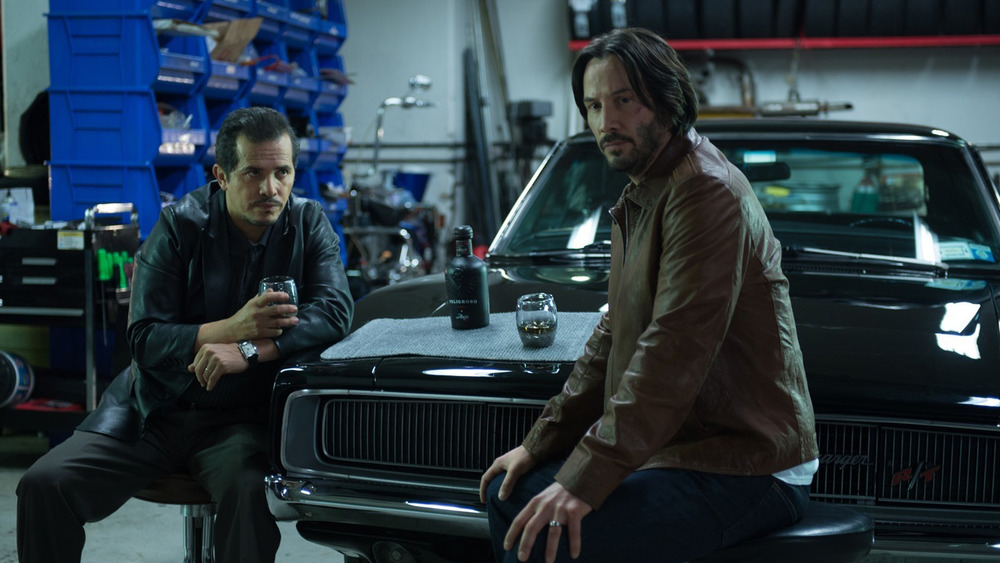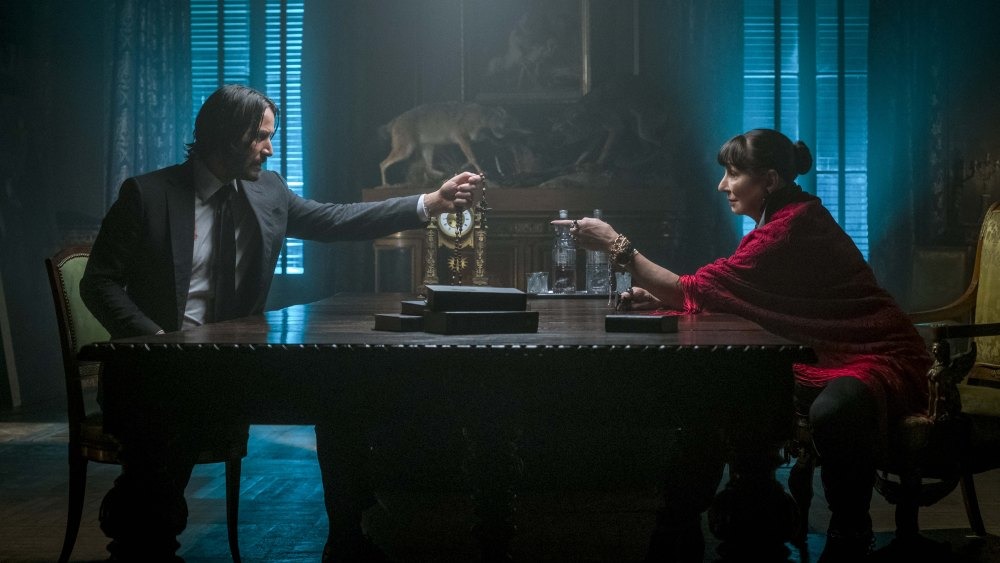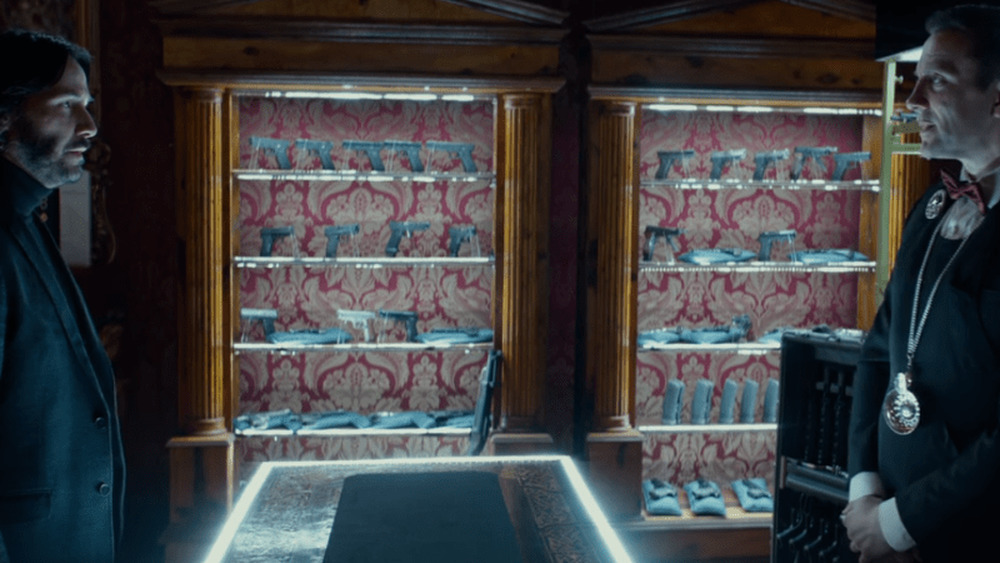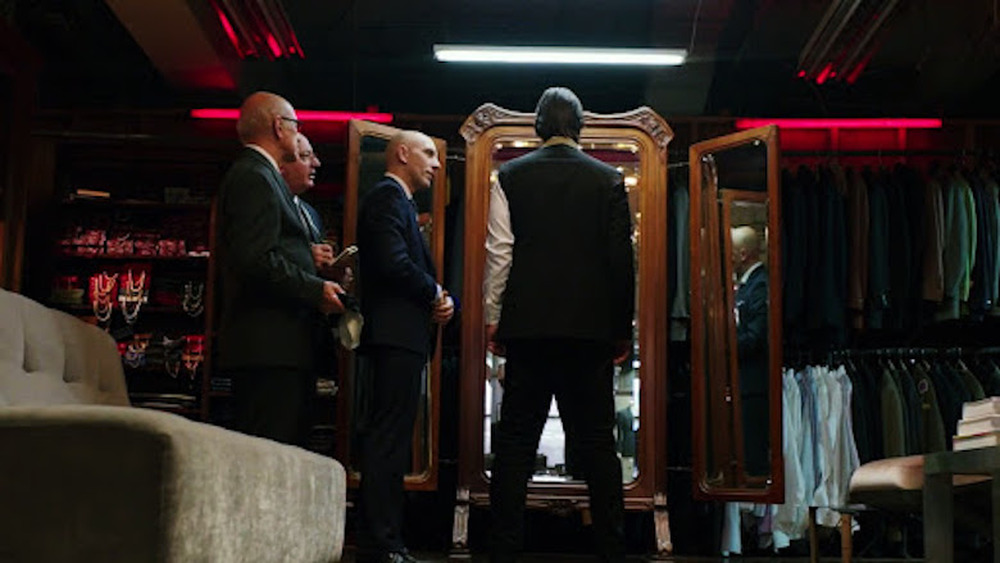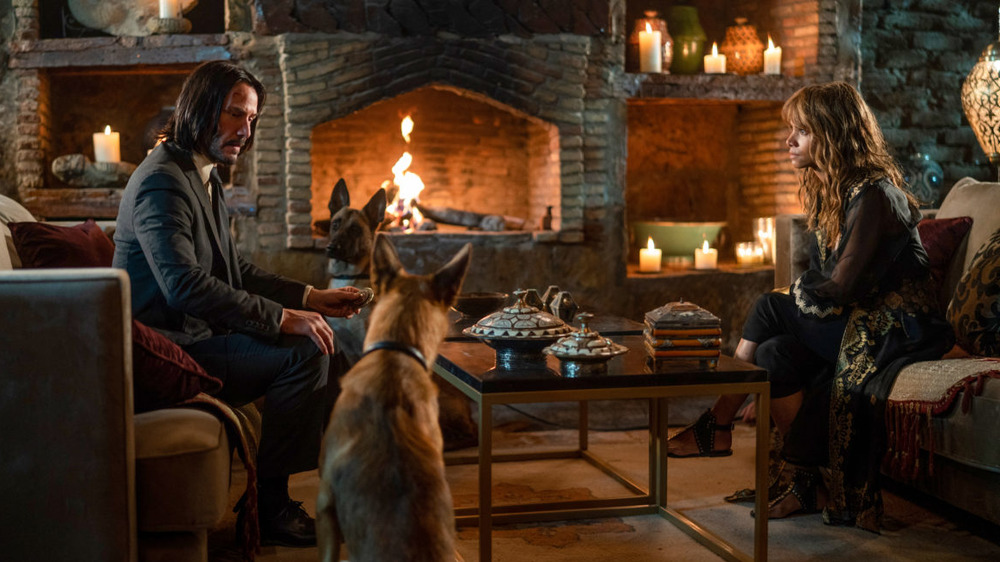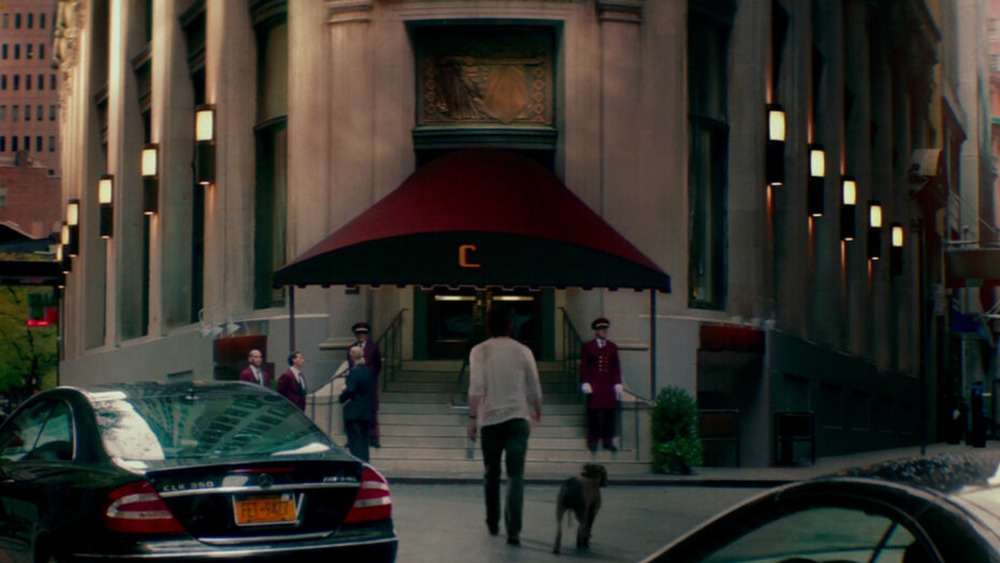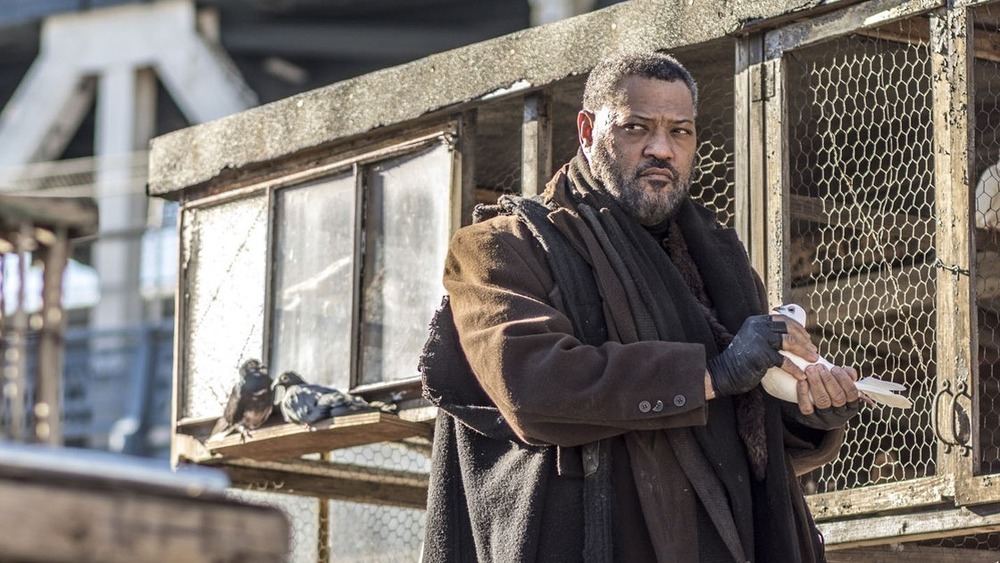Things John Wick Can't Live Without
Super-assassin John Wick has a long list of things he'd very much like to live without. For example, he doesn't need any more Russian mobsters' sons out to kill his dogs. He definitely doesn't need double-crossers like Santino D'Antonio disrupting his entire life. He sure doesn't need anyone else messing with his cars. He doesn't need any additional contracts on his head. He also doesn't seem to need even a shred of privacy: Everywhere he goes, people recognize him, even when he's been out of the assassin game for five years.
No, John Wick really doesn't need much to live his life in the blood-spattered manner to which he is accustomed. His is a life of brutal simplicity — like Henry Thoreau, but, you know, with a whole bunch of murder added in. However, there are a number of things that John Wick does need as his rampage escalates across his three-and-counting movies. With all that in mind, we're here to take a look at some of the things that John Wick cannot live without.
His reputation, integrity, and sense of justice
John Wick might be — strike that, totally is — a cold-blooded contract killer who ends lives for a living, but the man still has a solid code of ethics and an impressive reputation. He is, after all, called "the boogeyman" by many, and at one point, Viggo Tarasov clarifies John's scary reputation with an important addendum: "John wasn't exactly the boogeyman. He's the one you sent to kill the f***ing boogeyman." It's this hard-earned stature as one of the deadliest men alive that gives John a competitive advantage, even after countless contracts have been put on his head. The Tarasov brothers go on to detail John's extreme focus, commitment, and sheer force of will. Without these, he's nothing. With them, he's a legend.
In Chapter 2, John becomes entangled with the double-crossing Santino D'Antonio. Santino forces John's hand, ordering him to kill Santino's sister Gianna, so Santino can assume her spot on the High Table. He then has the audacity to put a $7 million bounty on John's head for completing the mission. John knows what Santino has done is fundamentally wrong, however, and in the end, his ethics — however bloodily expressed — shine through. He allows Gianna to take her life on her own terms, and then goes after Santino, prompting Winston to say, "You stabbed the devil in the back. To him this isn't vengeance. This is justice." John might be violent, but his sense of right and wrong never leaves him, even in the midst of battle. Santino ignores that to his peril.
His extraordinary physical strength and fighting skills
John Wick is an expert marksman, and one who's as comfortable with bladed weapons as he is with guns. He is also clearly well-versed in a number of martial arts, some of which include jiu-jitsu, judo, and karate. If you've seen John Wick: Chapter 3 – Parabellum, then you know that John was raised by the Institute, a theater and ballet front that actually trains young assassins. His time there shows: Watching him fight is not dissimilar from watching a dancer at the top of their game. John's physical strength seems almost otherworldly at times, as well as his endurance: He takes hit after hit, bullet after bullet, and stab after stab... and just keeps getting up, over and over again.
One wonders if the Institute does more than just train its children. Might John Wick actually be an enhanced super-soldier, a la Captain America? It's hard not to speculate... but even if he's doesn't really have superpowers, the proof is in the bloody pudding. John Wick is, as every fan knows, skilled enough to turn an ordinary pencil from a writing implement into a deadly weapon. Tales that circulate in the underground world of hitmen and mobsters detailing his exceptional strength and fighting prowess are, if anything, "watered down."
Dogs
"When Helen died, I lost everything. Until that dog arrived on my doorstep. A final gift from my wife. In that moment, I received some semblance of hope. An opportunity to grieve unalone." It's easy to forget that in the earliest moments of its first installment, the John Wick saga begins as a family drama, with John and his wife Helen living happily together until her untimely death. But she lives on in Daisy, an adorable puppy that Helen posthumously gifts to John to help him remember his humanity. When Iosef Tarasov's goon kills Daisy, we see John die another small death... and then rise up in the towering, unstoppable rage that carries him through the rest of the film.
By the end of the first movie, John has adopted a pit bull that was on a shelter's kill list, and seems to have come back into himself a little. He names his new pup "Dog," likely because he doesn't want to get too attached as he did with sweet Daisy. The kind-eyed pet's effect is obvious, however: We see John soften every time he's around Dog. He even uses a precious gold coin to keep Dog safe when he's unable to protect him himself.
Chapter 3 introduces even more canine companions for John in the form of Sofia Al-Azwar's Belgian Malinois. They may not actually be John's dogs, but they certainly save his life, and Sofia's, on multiple occasions. John Wick can't go without a dog in his life for long — not even when he's carrying out a global rampage.
Cars
Over the course of the John Wick movies, muscle cars prove over and over again to be one of our titular hero's trademarks. From the Chevelle loaner John gets after Iosef Tarasov steals his Boss 429 Mustang to the 2011 Dodge Charger that helps him finish off his beef with the Tarasov crime family for good, John always seems to travel in style. But these vehicles aren't just gorgeous — they're useful. John has his work cut out for him across the entire franchise, but he would have had an exponentially harder time coming out on top without all the horsepower he avails himself of during his movies.
Even when they're getting destroyed, cars prove to be of use to John Wick. Seriously, imagine how much longer it would have taken him to figure out who broke into his house, beat him up, and killed his dog if the person in question hadn't also taken John's Mustang to a chop shop? One that, luckily enough, turns out to be run by Aurelio, one of John's closest allies? Aurelio, being a friend of the highest order, does his part to make things right for John by loaning him a new car. He knows as well as the audience does that this is a man who benefits from some seriously slick wheels.
The few friends he still has
When you're known as the boogeyman — or, even worse, the man you call if you need to have the boogeyman killed — it's hard to figure out who your real friends are. Add in all the double and triple-crossing the John Wick universe contains, and trust ends up being a very hard thing to come by. But John fortunately has a few key individuals in his life who act as true friends and allies. John's first such ally is Aurelio, the owner of the garage where John gets his replacement cars. They seem to have a long and friendly history we'll hopefully learn more about in future movies. Then there's Marcus, who seems to be equal parts rival and friend, whose true colors shine through when he dies trying to protect John. Yeah, he did try to kill him first in order to earn the bounty on John's head, but it was a half-hearted attempt. In the world of John Wick, that has to count as genuine camaraderie.
John is friendly with several cops, including Jimmy, who lets John off with a warning after a noise complaint, and Harry, who leaves John to his business of kicking Ms. Perkins' butt at the Continental. John also has an ally in the bus driver near his remote home, who kindly takes him off-route to Aurelio's after Iosef steals John's Mustang. John also seems friendly with the Doctor, who stitches him up at the Continental, and later at his office in Chinatown. After thinking about it, we're giving bonus points to the Doctor: John would have likely died without this particular ally's help more than once.
Gold coins, markers, and tattoos
The world of John Wick is chock-full of potent symbols, evidenced by its repeated use of coinage and tattoos. Gold coins bankroll the activities of everyone above and below the High Table, while "markers," silver coins marked by bloody thumbprints, symbolize blood oaths. John treats these items seriously: Before the events that set the franchise in motion early in the first film, he buried his past earnings in cement underneath his garage. Without this stash, he would not have been able to start buying his way toward justice. Later, a similar cache of coins kept in a security box at a clandestine bank saves John's butt after Santino D'Antonio burns down his house. The third movie reveals John's most colorful hiding place yet: A book of Russian fairy tales in the New York Public Library. The marker and rosary he retrieves from the library might seem like weird keepsakes for a hitman to have, but they end up being fundamental to John's survival — the rosary allows him entry to the Institute where his life as an assassin began, while the marker belongs to Sofia Al-Azwar, who owes him a crucial debt for saving her daughter.
John's enormous back tattoo also proves to be a valuable symbol — it allows him safe passage to Morocco so he can try to get the hit taken off his head. Getting the tattoo wasn't easy: John was branded with a hot poker and was warned by the Director that it meant he "can never come home." Still, in the end, it saved his life when he needed it most.
Lots and lots of guns
John Wick doesn't need weapons to be deadly ... but he also would not have lived this long without a whole lot of guns. He works with his own stash, which he buried under his and Helen's home after he left the assassin life, in the first movie, but later films introduce a whole new arsenal. When John is taken out of his familiar surroundings and sent to Rome to kill Gianna D'Antonio in Chapter 2, he re-ups his stock by going to see the Sommelier. In one of the John Wick series' more memorable moments of actual comic relief, the Sommelier describes all of his different weapons using only wine connoisseur terms. John plays along in perfect deadpan.
After Santino's betrayal, John negotiates seven bullets from the Bowery King, one of which he uses to kill Santino for ruining his life again. By Chapter 3, John is forced to use antique weapons when running from the Adjudicator's assassins. He still makes it work, however — which is no surprise, given that we're still talking about the guy who turned a pencil into a deadly weapon. By the end of Chapter 3, the Continental's concierge Charon raids their armory along with John for the final shootout. He's relied on a number of indispensable tools during his bloody saga, but guns might be the most fundamental physical thing John Wick needs in order to survive.
His tactical wardrobe
While John Wick has extraordinary fighting skills, it's not until Chapter 2 that we realize he also has a turbocharged wardrobe. When John goes to see The Tailor to get a fancy new suit for Gianna D'Antonio's ascendance gala, The Tailor asks him what kind of lining John would like. John replies that he would like something tactical, indicating that his clothing has sleek bulletproof technology built right in. In one particularly memorable scene near the end of Chapter 2, John thumps his jacket, sending dozens of bullets falling to the floor around him. Clearly, The Tailor is good at what he does.
These clothes doesn't just protect from projectiles, however: They also protect him from body blows and hits from other weapons. Unfortunately, though, his white dress shirt does not come with the same tactical lining, allowing John to get sliced by knives on several occasions when the fighting gets up close and personal. Clothes make the man, but they can't always work miracles.
Sofia Al-Azwar
Sofia Al-Azwar is a person, not a thing, but without her, John Wick would surely be dead. Sofia is the manager of the Casablanca Continental, and long ago, John helped her save her daughter. John brings his marker to Sofia, looking to cash it in with her help in finding The Elder, the only person who sits above the High Table. Only he could nullify the $14 million bounty on John's head. Sofia isn't exactly pleased to see John — she shoots him in the chest as her greeting. But hey, the bullet is thwarted by John's tactical wardrobe, which she likely knew about. That's basically a hug and a kiss in the world of assassins.
Sofia agrees to help John and interestingly does not allow him to cash in his marker. This means she still owes him a debt, even after almost getting killed (along with her dogs) in the effort to connect John with The Elder. How will that play out in the future? We don't yet know — but there's no way it won't be exciting.
The Continental
John Wick has a complicated relationship with The Continental, a chain of hotels run by the High Table, which serve as neutral ground for the criminal underworld. Though they're crawling with hitmen and gangsters, no "business" is conducted there. Even when he's not in the hotel's good graces, John Wick still cannot live without The Continental: In all John Wick chapters, John goes to Winston, the manager of the New York Continental, for help and guidance. After John kills Santino on Continental grounds, Winston even gives John a one-hour grace period to try and get ready for the attacks on him that will follow. Winston even gives John sanctuary in The Continental after he's been excommunicated.
In Chapter 2, the Roman Continental gives John and Cassian a moment to catch their breath from their epic fight after Gianna's suicide. Later, the Casablanca Continental allows John to reach Sofia, her mentor Berrada, and ultimately The Elder, who commutes John's death sentence.
It's highly likely that John Wick will indeed need to live without The Continental in future chapters, given Winston's Chapter 3 betrayal. But it probably won't be long before John is back in those plush hallways, eyeballing all the other members of the underworld.
The Bowery King
Reuniting Neo and Morpheus for the first time since The Matrix, Laurence Fishburne appears in John Wick: Chapter 2 as The Bowery King, adding an enormous amount of worldbuilding to the franchise. The Bowery King is a street enforcer, whose network of carrier pigeons and fake homeless people keep information flowing around New York City, totally off the grid. John gets help from The Bowery King in the form of seven bullets, one for each million on John's head.
But by the end of Chapter 3, The Bowery King has been brutalized by The Adjudicator for helping John. After John's betrayal by Winston, The Bowery King's disciple, The Tick-Tock Man, rescues John from whatever The Adjudicator would have done, had they found him on the sidewalk. At this point, John is so badly injured and incandescent with rage that The Bowery King's help is literally all that keeps him alive.
